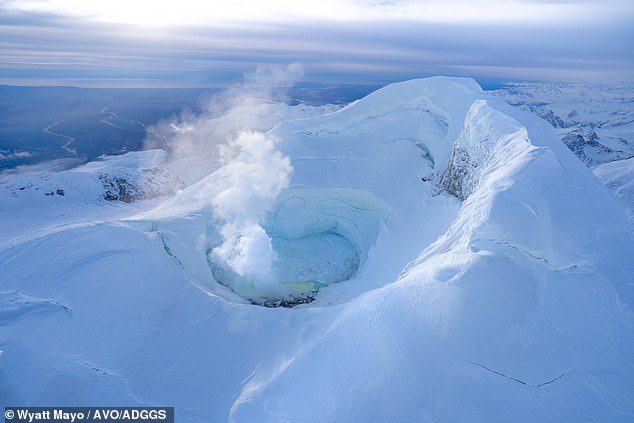
Researchers have issued a cautionary alert regarding a significant volcano located in Alaska, highlighting that it has a 50% probability of erupting in the near future.
Rising 11,000 feet high, Mount Spurr is situated just 77 miles from Anchorage—Alaska’s largest city, which houses close to 300,000 residents.
In the past 10 months, the volcano has been undergoing a notable increase in minor earthquakes.
Since the seismic events began in April 2024, the frequency of earthquakes has surged from an average of 30 per week to approximately 125 weekly, with a notable upturn observed in early October.
Experts at the Alaska Volcano Observatory (AVO) are investigating this seismic activity, which they suspect is fueled by new magma movements beneath the volcano, potentially indicating an impending eruption.
Should Mount Spurr erupt, it could produce explosive ash plumes, devastating mudflows known as lahars, and rapid avalanches of hot gas, ash, and rock called pyroclastic flows, which can travel down the volcano’s slopes at speeds exceeding 200 mph.
Fortunately, there are no communities situated directly in the potential trajectory of these pyroclastic flows or lahars from Mount Spurr.
However, the volume of ash generated during an eruption could pose serious health risks, leading to respiratory issues and the release of toxins associated with cancer.

Mount Spurr, an 11,000-foot-tall volcano, sits 77 miles from Anchorage, Alaska. An uptick in seismic activity over the last 10 minutes has scientists on alert for an imminent eruption.
The last eruption of Mount Spurr occurred in 1992, after the volcano had remained dormant for 39 years, following 10 months of rising seismic activity.
That event involved an eruption from the volcano’s Crater Peak side vent, resulting in an ash plume that soared to 65,000 feet above sea level.
In Anchorage, about a quarter-inch of ash fell, prompting residents to remain indoors or wear masks when outside.
Volcanic ash can be sharp and abrasive enough to disrupt jet engines, leading to the closure of Anchorage and nearby airports until conditions improved.
‘Currently, there are significantly more flights operating from Anchorage airport than during the last eruption, meaning a repeat occurrence would be very disruptive,’ stated Matt Haney, the AVO scientist-in-charge at the US Geological Survey, in an interview with LiveScience.
‘A significant ash cloud could also impact flights between North America and Asia that pass over Alaska,’ he added.
Haney and his team at AVO are closely monitoring the recent spikes in seismic activity surrounding Mount Spurr.
He confirmed to LiveScience that the data indicates a 50% chance of a similar eruption taking place again.

Since the seismic activity first began in April 2024, the rate of earthquakes has increased from an average of 30 per week to an average of 125 per week, ramping up in early October.

The last time Mount Spurr erupted in 1992, it covered Anchorage in a quarter-inch of ash, prompting residents to only venture outside wearing masks and forcing the airport to close.

While an impending eruption from the volcano’s side vent appears likely, it is also possible that the earthquakes subside without any volcanic activity.
‘The volcano has experienced an elevated number of earthquakes over the past several months,’ he noted.
‘In the last month, not only did the frequency heighten, but the epicenters of the earthquakes also shifted.’
Initially concentrated around the volcano’s peak, the seismic activity has now migrated approximately two miles down to the Crater Peak side vent, further suggesting that a volcanic event akin to the 1992 eruption may be on the horizon.
However, it remains a possibility that the seismic activity will cease without any eruption occurring.
This scenario has unfolded previously; in 2004 and 2005, Mount Spurr showed increased seismic activity yet returned to calm by 2006 without any eruptions occurring.
Another explanation for the uptick in seismic activity, although less likely, suggests that Mount Spurr may be gearing up for an eruption from its summit vent.
Such an eruption would likely be explosive, potentially leading to lava flows, lahars, and other water-related hazards, according to AVO.
While this is theoretically feasible, historical records do not indicate any eruptions from the summit crater of Mount Spurr.
Moreover, the transition of seismic activity from the summit to the Crater Peak side vent strongly supports the likelihood of an eruption occurring from the flank vent.
As of now, the two most plausible scenarios entail Mount Spurr either not erupting or erupting from the Crater Peak side vent. AVO researchers suggest both outcomes share equal likelihood.
Given this uncertainty, Haney and his colleagues remain vigilant, closely following any shifts in seismic activity that could imply an imminent eruption.
‘We anticipate observing further changes in monitoring data should an eruption occur as magma ascends toward the surface,’ noted AVO experts in a statement.
‘This would likely include further increases in earthquake frequency, sustained seismic tremors, heightened gas emissions, alterations in surface deformation, and melting of ice and snow.
‘In 1992, such changes were observed approximately three weeks prior to the first eruption.’









